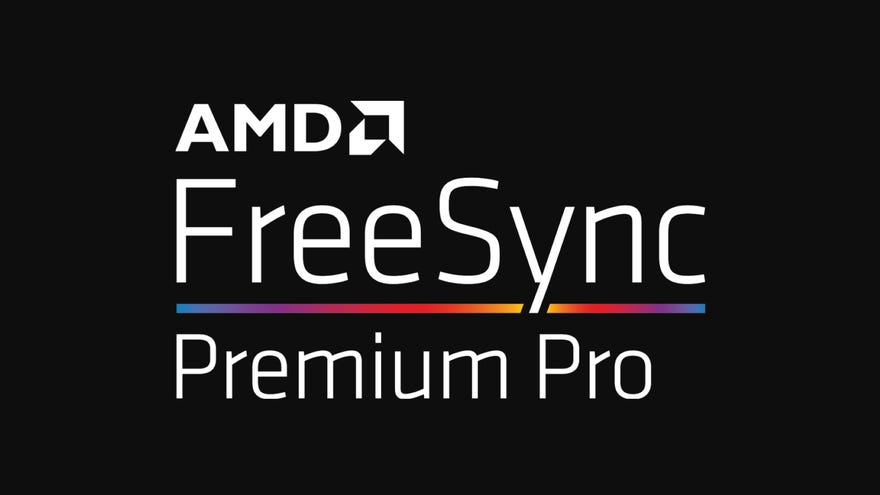AMD FreeSync 2 HDR is dead, long live FreeSync Premium and Premium Pro
Now there are three FreeSync standards to wrap your head around
On top of announcing their new Radeon RX 5600 XT graphics card and a bunch of new 3rd Gen Ryzen 4000 laptop processors yesterday, AMD also announced some changes to their various FreeSync standards at this year's CES. Until now, we had regular FreeSync and FreeSync 2 HDR, the latter offering exactly the same variable refresh rate tech for super smooth, tear-free gaming as regular FreeSync but with added HDR support.
Now, however, FreeSync 2 HDR has been canned in favour of two new standards, FreeSync Premium and FreeSync Premium Pro. Confused? Here's everything you need to know about the new tiers.
FreeSync is still FreeSync
At the bottom of AMD's new variable refresh rate tech tier, we've still got regular old FreeSync. This is the same as it's always been. Pair an AMD graphics card with an AMD FreeSync monitor and you'll get a smooth, tear-free gaming experience within the monitor's specified FreeSync range (normally 48fps up to whatever its maximum refresh rate is) and low latency guaranteed.
Regular FreeSync also works if you've got an Nvidia graphics card, but the experience can be a bit hit and miss. To absolutely make sure your Nvidia GPU can take advantage of a monitor's variable refresh rate tech, you'll probably want to opt for one of the officially certified < G-Sync Compatible monitors, which have been internally tested by Nvidia. Otherwise, you might find your games subject to weird visual defects, such as blinking, tearing, stutter, or brightness pulsing.
FreeSync Premium is a new standard for high refresh rate monitors
Next up we've got FreeSync Premium. This is a brand-new tier that sits between FreeSync and FreeSync Premium Pro and effectively clarifies some of the murkiness that surrounded the old, regular FreeSync standard. You still get low latency and a variable refresh rate for tear-free gaming, but FreeSync Premium monitors will now offer the following features as well:
- Low frame rate compensation (LFC)
- At least a 120 Hz refresh rate at minimum FHD resolution
LFC improves how a monitor performs below their minimum frame rate threshold. It does this by essentially duplicating the number of frames being shown onscreen when the frame rate drops too low, bringing 30fps up to 60fps, for example. A handful of regular FreeSync monitors used to have this feature built in, but most didn't, so at least that's one thing that's been cleared up by this new Premium standard.
The 120Hz refresh rate bit, meanwhile, means that a FreeSync Premium monitor must also have a refresh rate of at least 120Hz if it's got a 1920x1080 resolution. Dell's Alienware AW2518HF falls into this category, for example, as does our best gaming monitor champion the AOC 24G2U and its curved sibling, the AOC C24G1. For a full list of FreeSync Premium monitors, check out AMD's website.
FreeSync Premium Pro is the new FreeSync 2 HDR
Lastly, we've got FreeSync Premium Pro, which is pretty much the new name for FreeSync 2 HDR monitors. Monitors with a Premium Pro sticker on it will include everything you get on a normal Premium monitor (the LFC and at least a 120Hz refresh rate at 1080p), but will also include the following:
- Support for HDR "with meticulous colour and luminance certification"
- Low latency in SDR and HDR
Helpfully, AMD still haven't elaborated on what "meticulous colour and luminance certification" actually means (it's currently thought to sit somewhere between VESA's DisplayHDR 400 and 600 specifications, but no one knows for sure), but from the looks of things, this new tier is pretty much just a straightforward name change. As a result, you'll probably still see a variety of VESA DisplayHDR stickers appear alongside AMD's FreeSync Premium Pro badge on a monitor's product page depending on its HDR capabilities.
There were also a handful of games that had specific FreeSync 2 HDR support on the past, and these will continue to function as normal on FreeSync Premium Pro monitors, AMD have said. These include Assassin's Creed Odyssey, Borderlands 3, Call of Duty: Black Ops 4, Devil May Cry 5, Far Cry 5, Far Cry 5: New Dawn, Resident Evil 2, Strange Brigade, Ghost Recon Breakpoint and The Division 2.
That's pretty much your lot. Personally, I'm not sure these new standards make it any easier to understand what you're actually getting on any given FreeSync monitor. While it's good to finally have a more defined standard for AMD's LFC tech, removing the word "HDR" from the Premium Pro tier name just confuses things further in my eyes, although at least you'll probably still get VESA's various DisplayHDR stickers plastered all over the place to help make up for it.
Still, the biggest disappointment is the fact we still don't really know what AMD's HDR specifications actually entail. This could have been the moment we finally got some idea about what kind of minimum brightness levels, colour accuracy and black levels a FreeSync Premium Pro monitor has to have in order to qualify as an AMD-certified HDR monitor, but alas not. Instead, we'll have to continue to make do with VESA's various standards as our main guide and muddle on through. Maybe next time...
For more news from this year's CES, check out our CES 2020 tag.











